U.S. Department of Transportation
Federal Highway Administration
1200 New Jersey Avenue, SE
Washington, DC 20590
202-366-4000
Federal Highway Administration Research and Technology
Coordinating, Developing, and Delivering Highway Transportation Innovations
|
Research & Technology Transporter This newsletter is an archived publication and may contain dated technical, contact, and link information. |
|
| Publication Number: N/A Date: December 1996 |
Publication Date: December 1996
|
| Federico F. Peña Secretary, U.S. Department of Transportation |
| Rodney E. Slater Administrator, Federal Highway Administration |
| Jane F. Garvey Deputy Administrator, Federal Highway Administration |
| RTCG CHAIRPERSONS |
|---|
| Bud Wright--Safety Stan Gordon--Structures Jim Scapellato--Motor Carriers Paul Teng--Pavements Gary Euler--ITS Bob Ford--International Barna Juhasz--Policy, Planning, Environment, Information Management & Right-of-Way |
| Anne Barsanti, Managing Editor Jon Schans, Editor Zac Ellis, Editor |
On October 16-18, 1996, Federal, Provincial, and private sector officials associated with the Northumberland Strait Crossing Project (NSCP) in Canada visited the Norfolk, Virginia, area to review marine crossings. The NSCP is a 13-km long bridge connecting Prince Edward Island to New Brunswick, Canada, that is privately funded, designed, and constructed and is to be privately operated for the Canadian government for a thirty-five year period. The new toll bridge, scheduled for opening on May 31, 1997, will replace the existing ferry service between Borden, Prince Edward Island and Cape Tormentine, New Brunswick.
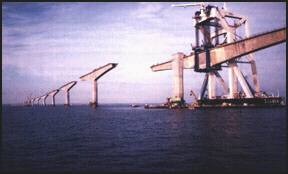
Bridge piers for the NSCP were built to withstand a wide range of environmental conditions.
In September of 1995, an FHWA-sponsored team of Federal, State, and private sector officials participated in an international scanning review of the NSCP concentrating on high performance materials, innovative finance and construction techniques and environmental planning and monitoring. A publication entitled "FHWA Study Tour of Northumberland Strait Crossing Project (NSCP)" documents the team's findings. The publication is available from FHWA's Office of International Programs.
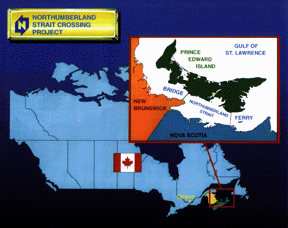
Map indicates location of Northumberland Strait Crossing Project.
As part of the final development and approval of the NSCP operating plan, Canadian officials were anxious to observe marine crossings in the United States to review maintenance strategies and operations; traffic control and surveillance; safety concerns including worker protection, emergency services, hazardous cargo, and police operations; environmental response actions, and toll collection features. Though the cooperative efforts of the Office of International Programs, the Virginia Division Office and the Office of Engineering R&D, a scanning visit of the Chesapeake Bay Bridge and Tunnel, connecting the Norfolk-Virginia Beach area to Virginia's Eastern Shore, was arranged. This 31.7 km bridge-tunnel complex was selected because it has many similar operating elements as will the new NSCP facility.
The Canadian delegation was hosted by Mr. Paul A. Burnette, Jr., Director of Maintenance and Mr. Clem M. Pruitt, Director of Operations and Chief of Police, of the Chesapeake Bay Bridge and Tunnel District. The scanning visit consisted of technical sessions of various operating and maintenance topics held at the Chesapeake Bay Bridge and Tunnel District's offices in Cape Charles, Virginia; visits to all the operations and toll collection facilities, observation of the mid crossing wildlife refuge, and finally a tour of the new parallel bridge facilities now under construction which will eventually expand the present two-lane facility to four lanes. Some of the marine construction equipment currently being used on the NSCP will be towed to the United States and will be utilized on the construction of the new Chesapeake Bay Bridge and Tunnel crossing.
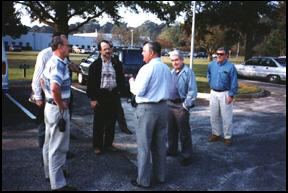
Paul Burnette Jr., Director of Maintenance for Chesapeake Bay Bridge and Tunnel District, briefs Canadian delegation prior to viewing toll-collection facility.
The group was also hosted by the Virginia Department of Transportation in a visit to the Monitor-Merrimac Memorial Bridge-Tunnel. Of prime interest in this visit was the TV-surveillance system used on the facility and the courtesy escort operations and motorist patrol services.
The Canadian delegation was led by James Feltham, Project Manager, NSCP, Public Works and Government Services Canada and Pierre Lafarge, General Manager, Strait Crossing Development Inc., the private consortium responsible for building and operating the NSCP. The group was accompanied by Don Holloway and Claude Napier of the FHWA Virginia Division and Lou Colucci of the Office of Engineering R&D. Colucci was the prime FHWA coordinator for the September 1995 US. Delegation visit to the NSCP.
-- Lou Colucci (202) 493-3076
Buffalo, N.Y., provided a beautiful fall backdrop for the 1996 American Association of State Highway and Transportation Officials (AASHTO) Technology Fair, which took place on October 5-7, 1996, amidst AASHTO's Annual Meeting and FHWA's Annual Meeting. Over 82 exhibitors displayed a broad array of transportation products and technologies to an audience of State and Federal transportation officials.
FHWA departed from its traditional array of technical demonstrations at this year's gathering, providing instead an exciting environment for information exchange and high-tech browsing. Transportation officials attending the AASHTO Annual Meeting were welcomed into the FHWA pavilion by top FHWA managers who provided personal guided tours around the customized 209 m2 exhibit area. Framed by the four pillars of "Innovation, Partnership, Quality, and Service," the pavilion presented intelligent transportation system (ITS) initiatives, tours of the ALERT (advanced law enforcement response technology) vehicle, and technical discussions of Strategic Highway Research Program (SHRP) Road Savers program and Superpave. Highway Information Management and Quality Roundtable displays provided the backdrop for some dynamic discussions of ongoing programs and policy issues. Two workstations were staffed and available for visitors to browse the home pages of FHWA, the Office of Technology Applications, Research and Development, and other available resources on the Internet.

FHWA pavilion at AASHTO meeting greeted visitors with four pillars of success.
Also associated with the FHWA pavilion was an exhibit gallery highlighting the 40th anniversary of the Dwight D. Eisenhower System of Interstate and Defense Highways. Featured in the gallery were exhibits displaying the engineering marvels of the era -- highlighting challenging segments of this project, "men of vision" -- kudos to the founding fathers of the Interstate System, and a commemorative roadtour display.
The FHWA also bridged AASHTO's meeting facility and the Technology Fair with its display of photos submitted to the 1996 "Excellence in Highway Design" competition. This biennial event recognizes excellence in the planning, design, and development of safe, functional, and environmentally sensitive transportation projects from State and local governments, private sector groups, and Federal agencies. Winners of this year's competition were announced at AASHTO's Annual Meeting.
-- Martha Soneira (202) 366-8029
Since its inception 10 years ago, the Strategic Highway Research Program (SHRP) has improved the safety and efficiency of our Nation's highways by unlocking the potential of a number of new technologies. To celebrate the accomplishments of SHRP, a special session at this year's Transportation Research Board (TRB) Annual Meeting, titled SHRP in '97: A Model for Bringing Research to Reality will be held. This session will highlight SHRP achievements, the people who made SHRP happen, and the partnerships that developed because of SHRP. The session program will reflect on the products and technologies developed during the life of the 5-year research program, the ongoing effort to implement these products in A real-world@ settings, an assessment of costs and benefits, and a look at the future implementation efforts under the next highway authorization bill. All TRB attendees are invited to the session which will take place from 3:30-5:15 p.m. on Sunday, January 12, in the Washington Ballroom of the Sheraton Washington Hotel, Washington, D.C.
Another key event on SHRP at the TRB Annual Meeting will be the SHRP Road Savers Fair. This exhibit, in Exhibit Hall B at the Sheraton Washington Hotel. The fair will give meeting attendees an opportunity to discuss SHRP technology such as Superpave, High Performance Concrete, the Long Term Pavement Performance (LTPP) database and other LTPP products; anti-icing and road weather information systems; and innovative pavement maintenance materials and techniques. Lead States and experts in these technology areas will be on hand to discuss these technologies and demonstrate equipment and procedures.
-- Margie Sheriff (202) 366-1747
How can transportation practitioners grab and hold people's interest in projects or plans and offer a way for people to provide valuable input for agency decisions? "Public Involvement Techniques for Transportation Decision-making" is a practical new publication presenting nearly 100 public involvement techniques, either individually or as groups of related techniques. The report includes such staples of public involvement as civic advisory groups, mailing lists, ways to reach ethnic, minority, and low-income groups, open forum hearings, open houses, and key person interviews. Less common techniques discussed include interactive television and games and contests.
The report provides practitioners with compact and systematic descriptions of the techniques. The descriptions focus on practical information: a definition of the technique, its usefulness, cost, staff needs, relationships to other techniques, intended audience, drawbacks, and some contacts for more information. Cross-references in the margins lead readers to related techniques. To help practitioners get started, the report provides suggested initial steps for implementation. Careful use of a variety of these techniques by transportation agencies will ensure that we plan, design, and build the transportation system America must have to address the challenges and opportunities of the next century.
This report will serve as an important resource for public involvement specialists, transportation planners, project managers, and the general public. It has been distributed widely to State departments of transportation, metropolitan planning organizations, and transit agencies. For additional copies, fax Benita Smith at (202) 366-3409 or call the publications hotline at (202) 366-2069.
-- Florence Mills (202) 366-2062
A transition from a W-beam on strong post guardrail to the Texas Type T101 bridge rail was recently crash tested with a 2,000-kg pickup truck. The purpose of the test was to determine whether this transition meets the strength requirements for Test Level Three of the National Cooperative Highway Research Program (NCHRP) Report No. 350. The pickup truck impacted the transition at 100 km/h and an impact angle of 25 degrees. It was smoothly redirected and remained upright. Damage to the transition was relatively minor.
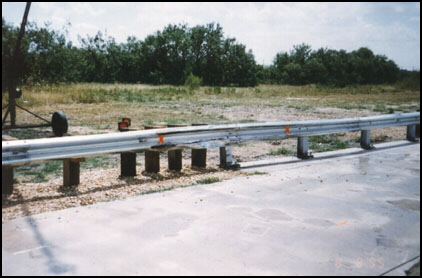
Transition after crash test with a pickup truck.
-- Charles McDevitt (202) 493-3313
A composite traffic barrier (composite rail system) was tested recently at FHWA's Federal Outdoor Impact Laboratory (FOIL). The tests were performed using the FOIL's large outdoor pendulum and roughly emulated a small to mid-size automobile colliding with the composite rail system at a speed of 100 km/h and an approach angle of 20-25 degrees. The composite rail sections tested were hand fabricated and composed of a fiberglass composite material.
Why are composite materials such as fiberglass important to FHWA? Fiberglass is a composite material in which long glass fiber strands are imbedded in a surrounding plastic material. Today, fiberglass is used exclusively in the fabrication of recreational boat hulls and is also used in various automotive applications including crashworthy front ends. The glass fiber strands give the material great strength and the surrounding plastic material is used to bind the glass-plastic combination together as one material system. The advantages of composite materials such as fiberglass over the common construction materials of today (steel, concrete, and wood) are several. One is the material's innate resistant to corrosion. Another is the material's internal structure which can be custom fabricated to develop high strength in needed directions with attendant superior impact performance.
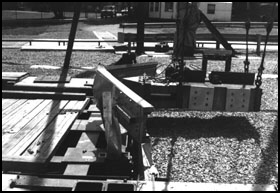
Composite rail tested for energy absorption by FOIL pendulum.
Composite materials do not have strength and stiffness properties that are the same in all directions (they are not isotropic), and, as such, they are much more difficult to analyze for potential design applications. This is one reason why composite materials have not been widely used in the transportation infrastructure to date.
This composite rail system development is part of an on-going cooperative agreement between FHWA and the Catholic University of America. Creative Pultrusions, Inc. is the composite material supplier and the tentative manufacturer of the rail system. Additional research on this composite rail is required. The composite rail system is far from finalized. Optimization of the rail's cross-section to insure maximum energy absorption, optimization for manufacturing, subsequent production of manufactured prototypes, additional pendulum testing, and full-size vehicle crash testing to determine the system's crashworthiness lay ahead.
-- Martin W. Hargrave (202) 493-3311
In the days of the Roman Empire visibility might be diminished by sand in ones' eyes or by arrows coming at you from the Huns. Nowadays, while driving on our roads in an air-conditioned vehicle, visibility constraints are not generally expected except by environmental conditions. However, during the Ides of March (the early to middle of March, according to the Roman Calendar), we were alerted about a visibility problem with variable message signs (VMS) using light emitting diode (LED) technology for drivers wearing certain types of sunglasses. Smelling an intriguing opportunity to show our investigative prowess, we put on our Sherlock Holmes hat and, with the help of Dr. Watson, tried to get to the bottom of things!
We soon determined that the sunglasses in question attenuated very strongly in the visual spectrum where yellow/amber LEDs emit their visible energy. Not many types of sunglasses exhibit this characteristic, but those which do are excellent at making the messages of VMSs, using yellow/amber LEDs, almost invisible on a bright sunny day.
Our friend Sherlock secured samples of the sunglasses and LEDs. The Photometric and Visibility Laboratory has a spectroradiometer which can measure the spectral emittance of a light source as well as the spectral transmittance of a filter, i.e. the lens of sunglasses. Using this instrument, we quickly realized that the sunglasses in question severely attenuated light of wavelengths between 580 and 600 nm. The yellow-amber LEDs emit most of their energy around 590 nm. Putting these two findings together, we deduced why one of the engineers from the Maryland State Highway Administration thought the newly installed VMS was defective.
While these effects can be very dramatic on a bright, sunny day, the impact is not quite as severe on an overcast or rainy day. The sunglasses investigated attenuate the LED signal the same in sunny or rainy weather, but they do not attenuate the brightness of the surrounding landscape to the same degree. This causes the contrast between surroundings and the sign itself to change with changes in ambient lighting conditions.
Watson and Holmes did a little more investigating! First, they determined that the LEDs in question were within the color boxes specified by the Institute of Transportation Engineers (ITE). Then they found an American National Standard (ANSI Z80.3-1986) covering the optical performance of nonprescription sunglasses. Since this ANSI standard is based on a broad-spectrum light source, all the sunglasses we investigated met the ANSI requirements.
Dr. Watson turned these findings over to the Sunglass Association of America, the manufacturers of VMS, and to ANSI. ANSI is currently revising Z80.3-1986 and, hopefully, will consider narrow-band light sources, such as LEDs and certain types of lamps used for tunnel lighting, in their standards revision. The sunglass manufacturers have alerted their members to the problem.
Since LEDs save energy and require less maintenance, we can expect the use of LEDs in more and more applications. Hopefully, these investigations have alerted all parties involved in this project. With an ever changing technology, it is utterly important to be aware of developments and applications of new devices designed to improve safety while at the same time cutting energy consumption and maintenance costs. Keeping lines of communication open between manufacturers, standards writing organizations, and governmental agencies should be, as Sherlock Holmes would say, "elementary, my dear Watson!"
-- John Arens (202) 493-3364
That was the title of a prominent article appearing in a Memphis newspaper on February 16, 1996. The story behind that article involves: 1988 legislation signed by President Reagan which established a Commission chaired by then Governor Bill Clinton; a 1990 program by the Cable News Network; a 1995 update by the FHWA with assistance from several dozen Federal, State, and other organizations which was initiated by Administrator Slater who served as an adviser to the Commission; and a pooled-fund study supported by 13 southern States and the FHWA. The story also features a key word: Jobs
The 1990 CNN program was developed as the Commission was working to produce recommendations on regional development. During the program, a number of residents of the lower Mississippi Delta were asked what they most needed. In spite of the well known deficiencies in education, medical care, etc., essentially all of them, from Governors to social workers said, "Jobs," or words to that effect. During the 1995 update, jobs were found to have increased dramatically -- 15%, 30%, even 80% -- in specific counties and parishes, especially those which had high unemployment and low per capita income, in which highway improvements had been implemented. This got the attention of appointed and elected leaders (and the newspaper). It also provided an empirical 'reality' check point that tends to validate four decades of productivity research.
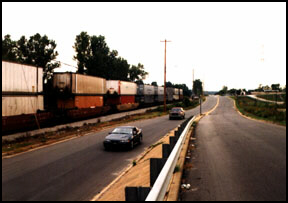
Projects such as these double-stacked train cars near the port of Memphis have spurred development in the Delta region.
Subsequent studies suggest that about half of the job growth was the result of highway improvements in economically developing counties and parishes without gaming influence; and about a third in other counties and parishes.
The jobs/highway relationship and the influence of increasing foreign trade is to be a key subject of the pooled-fund study. The progress of this study, the RFP for which was issued in October 1996 by the Mississippi DOT, will be watched by both elected officials and various private organizations. If the result is consistent with the earlier cited work, and with recent related research, it could have a substantial impact on State transportation improvement programs and even on future surface transportation authorizations, perhaps including the 1997 one.
-- Martin Weiss (202) 366 5010
In 1992 the Information and Behavior Systems Division participated in a Small Business Innovation Research contract to study the feasibility of creating a system for the automated reduction of video-based data. Specifically, researchers in the Human Factors Laboratory needed a way to quickly analyze a vehicle's lateral placement in the field. Lateral placement, along with other measurements such as steering wheel inputs and speed variability, is an important performance measurement.
The task of developing the systems was given to DBA Systems, who recently delivered a working prototype of the Lateral Placement Tracking System to the Human Factors Laboratory. This prototype is an outgrowth of previous DBA efforts on missile tracking and video mensuration.
The system allows researchers to use small video cameras attached to an instrumented field research vehicle to easily gather lateral placement data. After implementing a calibration routing to establish known distances in the video image, data is collected in real world settings. The system then compares these images of pavement markings on both sides of the vehicle to provide an accurate measurement of lateral placement.
This new system will save large amounts of time and improve the accuracy of measurements in determining lateral placement of vehicles. Before the delivery of this device, researchers had to measure an image and convert that measurement into a distance by hand, taking six to eight hours of processing time for every hour of videotape. With this new system, that time can be reduced to about one and a half hours, with extensive improvements in accuracy.
--Truman Mast, gus.mast@fhwa.dot.gov
On October 17, 1996, FHWA announced the availability of a new fact book, "Transportation Air Quality: Selected Facts and Figures." After the passage of the Clean Air Act and the Intermodal Surface Transportation Efficiency Act (ISTEA), which strengthened the legal and regulatory links between transportation and air quality, many decision-makers and the public did not fully understand the relationship between transportation and air quality. This fact book assists our customers in understanding the direct and indirect links between transportation and air quality. The fact book provides concise, focused information on many of the nation's key air quality trends and projections. Each topic area is also accompanied by colorful, easily-understood graphics.
The air quality fact book provides decisionmakers and the public brief overviews of key topic areas such as improvements that have been realized in air quality; the effects of the pollutants carbon monoxide, hydrocarbons, nitrogen oxides, and particulate matter on human health; the tightening of Federal emission standards; and the significant reductions in transportation emissions.
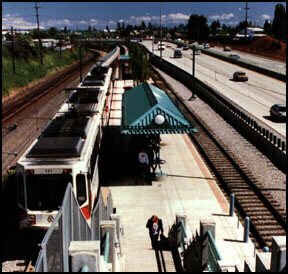
As congestion and associated air quality worsen, intermodal options like this offer solutions.
The fact book also contains data on travel trends in the U.S., including indirect, yet contributing data on vehicle miles traveled, economic growth and population, and general demographic trends, as well as national nonattainment area maps. Brief sections on policy responses and agency initiatives such as inspection and maintenance programs, transportation control measures, and funding mechanisms such as the Congestion Mitigation and Air Quality Program are highlighted in the fact book.
Copies of "Transportation Air Quality: Selected Facts and Figures" can be obtained by contacting the FHWA Hotline at (202) 366-2069. Please refer to the publication number FHWA-PD-96-006.
-- Phillis Johnson-Ball (202) 366-5448
How can transportation practitioners grab and hold people's interest in projects or plans and offer a way for people to provide valuable input for agency decisions? "Public Involvement Techniques for Transportation Decision-making" is a practical new publication presenting nearly 100 public involvement techniques, either individually or as groups of related techniques. The report includes such staples of public involvement as civic advisory groups, mailing lists, ways to reach ethnic, minority, and low-income groups, open forum hearings, open houses, and key person interviews. Less common techniques discussed include interactive television and games and contests.

The report provides practitioners with compact and systematic descriptions of the techniques. The descriptions focus on practical information: a definition of the technique, its usefulness, cost, staff needs, relationships to other techniques, intended audience, drawbacks, and some contacts for more information. Cross-references in the margins lead readers to related techniques. To help practitioners get started, the report provides suggested initial steps for implementation. Careful use of a variety of these techniques by transportation agencies will ensure that we plan, design, and build the transportation system America must have to address the challenges and opportunities of the next century.
This report will serve as an important resource for public involvement specialists, transportation planners, project managers, and the general public. It has been distributed widely to State departments of transportation, metropolitan planning organizations, and transit agencies. For additional copies, fax Benita Smith at (202) 366-3409 or call the publications hotline at (202) 366-2069.
-- Florence Mills (202) 366-2062